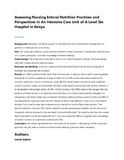Assessing Nursing Enteral Nutrition Practices and Perspectives in An Intensive Care Unit of A Level Six Hospital in Kenya
Abstract
Background: Adequate nutritional support is important for the comprehensive management of patients in intensive care units (ICUs).
Aim: The study was aimed to survey prevalent enteral nutrition practices in the general intensive care unit, nurses' perception, and their knowledge of enteral feeding.
Study Design: The study was conducted in the ICU of a level 6 hospital in Kenya. The study design used was crosses sectional descript study.
Materials and Methods: thirty four questionnaires were distributed and the results analyzed. A database was prepared and analyzed.
Results: all (100%) questionnaires were filled and returned. A majority (32) of staff nurses expressed awareness of nutrition guidelines. A large number (27) of staff nurses knew about existence of nutrition protocols in the ICU. Almost all nurses (82.4%) chose enteral nutrition as their preferred route of nutrition unless contraindicated. All staff nurses were of the opinion that enteral nutrition is to be started at the earliest (within 24-48 h of the ICU stay). Half (50%) were of the thought that the absence of bowel sounds is an absolute contraindication to initiate enteral feeding. Passage of a nasogastric tube (Ryle’s tube) was considered mandatory before starting enteral nutrition by 86% of the respondents. Everyone knew that the method of Ryle's tube feeding in their ICU is intermittent boluses. Only 4 staff nurses were unaware of any method to confirm Ryle's tube position. The backrest elevation rate was 70%. Gastric residual volumes were always checked, but the amount of the gastric residual volume for the next feed to be withheld varied. The majority said that the unused Ryle's tube feed is to be discarded after 24 h. The most preferred (48%) to upgrade their knowledge of enteral nutrition as a personal initiative and CME.
Conclusion: Information generated from this study can be helpful in identifying nutrition practices gaps and may be used to review and revise enteral feeding practices where necessary.
URI
https://doi.org/10.24203/ajpnms.v8i6.6432https://ajouronline.com/index.php/AJPNMS/article/view/6432
http://r-library.mmust.ac.ke/123456789/1788
Collections
- Journal Articles [411]

